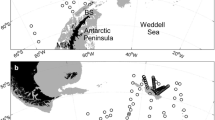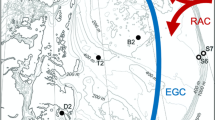Abstract
If Southern Ocean plankton communities are changing in response to climate, biases in various nets need to be evaluated to help understand regional and temporal differences between historical and contemporary sample collections. A comparison of the catching ability of a Bongo net (mesh aperture 200 μm) and a reconstructed version of an N70 net (upper mesh aperture 445 μm, lower mesh aperture 195 μm) as used by the Discovery Investigations was therefore undertaken. Forty Bongo and forty N70 samples were obtained from 10 stations in the Southern Ocean during December 2009. Bongo net catch abundance was ~3 times greater than the N70 and ~4 times greater when only copepod instars <0.5 mm body length were considered. The Bongo net captured more plankton at all chlorophyll a (Chl a) concentrations encountered, although the difference was less at high Chl a when the N70 appeared to filter all size classes of copepod more efficiently, as well as retaining a relatively greater proportion of non-copepod plankton. Application of these findings was made to a previous study in which N70 samples from 1926/1927 were compared to a series of Bongo net hauls made post-1995. By ‘correcting’ abundances for net bias among a common set of 45 taxa, N70 data were within the range of variability seen in the Bongo net samples. Making such inter-net comparisons allows us to use historical collections and better judge the nature and magnitude of change in these plankton communities.






Similar content being viewed by others
References
Atkinson A, Siegel V, Pakhomov EA, Rothery P (2004) Long-term decline in krill stock and increase in salps within the Southern Ocean. Nature 432:100–103
Forcada J, Trathan PN, Reid K, Murphy EJ (2005) The effects of global climate variability in pup production of Antarctic fur seals. Ecology 86:2408–2417
Forcada J, Trathan PN, Reid K, Murphy EJ, Croxall JP (2006) Contrasting population changes in sympatric penguin species in association with climate warming. Glob Change Biol 12:411–423
Gille ST (2002) Warming of the Southern Ocean since the 1950s. Science 295:1275–1277
Gille ST (2008) Decadal-scale temperature trends in the Southern Hemisphere ocean. J Clim 21:4749–4765
Hardy AC, Gunther ER (1935) The plankton of the South Georgia whaling grounds and adjacent waters 1926–1927. Discov Rep 11:1–456
Kawamura A (1986) Has marine Antarctic ecosystem changed? A tentative comparison of present and past macrozooplankton abundances. Mem Nat Inst Polar Res Special Issue 40:197–211
Kawamura A (1987) Two series of macrozooplankton catches with the N70 V net in the Indian sector of the Antarctic Ocean. Proc NI PR Symp Polar Biol 1:84–89
Kemp S, Hardy AC, Mackintosh NA (1929) The Discovery Investigations, objects, equipment and methods. Part 2. The ships, their equipment and the methods used in research. Discov Rep 1:151–222
Levitus S, Antonov JI, Boyer TP (2005) Warming of the world ocean, 1955–2003. Geophys Res Lett 32:L02604. doi:10.1029/2005GL023112
Loeb V, Hofmann EE, Klinck JM, Holm-Hansen O (2010) Hydrographic control of the marine ecosystem in the South Shetland-Elephant Island and Bransfield Strait region. Deep Sea Res II 57:519–542
Mackey A, Atkinson A, Hill S, Ward P, Cunningham N, Johnston NM, Murphy EJ (2012) Antarctic macrozooplankton of the SW Atlantic sector and Bellingshausen Sea: baseline historical distributions (1928–1935) related to temperature and food, with projections for subsequent ocean warming. Deep Sea Res II 59–60:130–146
Moline MA, Claustre H, Frazer T, Schofield O, Vernet M (2004) Alteration of the food web along the Antarctic Peninsula in response to a regional warming trend. Glob Change Biol 10:1973–1980
Rebstock GA (2001) Long-term stability of species composition in calanoid copepods off southern California. Mar Ecol Prog Ser 215:213–224
Ross RM, Quetin LB, Martinson DG, Iannuzzi RA, Stammerjohn SE, Smith RC (2008) Palmer LTER: patterns of distribution of five dominant zooplankton species in the epipelagic zone west of the Antarctic Peninsula, 1993–2004. Deep Sea Res II 55:2086–2105
Shreeve RS, Ward P, Whitehouse MJ (2002) Copepod growth and development around South Georgia: relationships with temperature, food and krill. Mar Ecol Prog Ser 233:169–183
Smith RC, Fraser WR, Stammerjohn SE, Vernet M (2003) Palmer long-term ecological research on the Antarctic marine ecosystem. In: Domack E, Leventer A, Burnett A, Bindschadler R, Convey P, Kirby M (eds) Antarctic Peninsula climate variability; historical and paleoenvironmental perspectives, vol 79. Antarct Res Ser, pp 131–144
Trathan PN, Forcada J, Murphy EJ (2007) Environmental forcing and Southern Ocean marine predator populations: effects of climate change and variability. Philos T R Soc B 362:2351–2365
Vanucci M (1968) Loss of organisms through the meshes. In: Tranter DJ (ed) Zooplankton sampling. Monogr Oceanogr Methodol, vol 2. Unesco, Paris, pp 77–86
Vuorinen I, Hänninen J, Bonsdorff E, Boormann B, Angel MV (1997) Temporal and spatial variation of dominant pelagic Copepoda (Crustacea) in the Weddell Sea (Southern Ocean) 1929 to 1993. Polar Biol 18:280–291
Ward P, Shreeve R, Atkinson A, Korb B, Whitehouse M, Thorpe S, Pond D, Cunningham N (2006) Plankton community structure and variability in the Scotia Sea: austral summer 2003. Mar Ecol Prog Ser 309:75–91
Ward P, Whitehouse MJ, Shreeve R, Thorpe S, Atkinson A, Korb R, Pond D, Young E (2007) Plankton community structure south and west of South Georgia (Southern Ocean): links with production and physical forcing. Deep Sea Res I 54:1871–1889
Ward P, Meredith MP, Whitehouse MJ, Rothery P (2008) The summertime plankton community at South Georgia (Southern Ocean): comparing the historical (1926/27) and modern (post 1995) records. Prog Oceanogr 78:241–256
Ward P, Atkinson A, Tarling GA (2012) Plankton community structure and variability in the Scotia Sea: a seasonal view. Deep Sea Res II 59–60:78–92
Weimerskirch H, Inchausti P, Guinet C, Barbraud C (2003) Trends in bird and seal populations as indicators of a system shift in the Southern Ocean. Antarct Sci 15:249–256
Whitehouse MJ, Meredith MP, Rothery P, Atkinson A, Ward P, Korb RE (2008) Rapid warming of the ocean around South Georgia, Southern Ocean, during the 20th century: forcings, characteristics and implications for lower trophic levels. Deep Sea Res I 55:1218–1228
Whittaker RH (1952) A study of summer foliage insect communities in the Great Smoky Mountains. Ecol Monogr 22:1–44
Whittaker RH, Fairbanks CW (1958) A study of plankton copepod communities in the Columbia Basin, southeastern Washington. Ecology 39:46–65
Acknowledgments
We thank the officers and crew of RRS James Clark Ross for assistance at sea and the chief scientists of cruises JR228 and JR230 for the opportunity to undertake this research. Rebecca Korb kindly undertook the Chl a determinations.
Author information
Authors and Affiliations
Corresponding author
Rights and permissions
About this article
Cite this article
Ward, P., Tarling, G.A., Coombs, S.H. et al. Comparing Bongo net and N70 mesozooplankton catches: using a reconstruction of an original net to quantify historical plankton catch data. Polar Biol 35, 1179–1186 (2012). https://doi.org/10.1007/s00300-012-1163-x
Received:
Revised:
Accepted:
Published:
Issue Date:
DOI: https://doi.org/10.1007/s00300-012-1163-x




